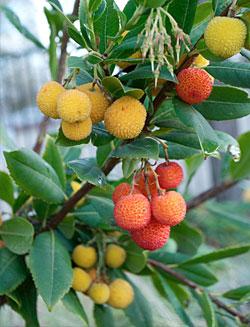Water-Efficient Landscape Gardens in December
Home » Fair Oaks Horticulture Center » WEL Gardens » December in the WEL
The WEL gardens at the Fair Oaks Horticulture Center are open to the public seven days a week from sunrise to sunset for self-guided tours.
Wheelchair accessible, the gardens feature natives, commonly available perennials, trees, shrubs, and plants from other Mediterranean climates that do well with less water during our long, hot, dry summers and tolerate our chilly, damp Sacramento County winters. Most plants are labeled and many are UC Davis Arboretum All-Stars. The landscape demonstrates how home gardeners can be smart about using the water we have to create beautiful landscapes. (For more information see Gardening with Limited Water.)
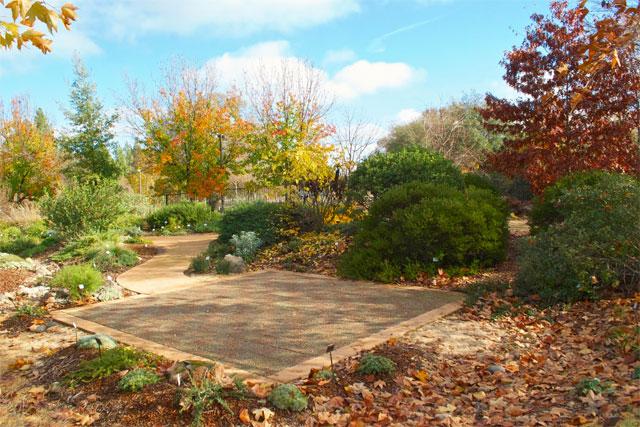
Days are shorter, nights are cooler, the sun lower in the sky, leaves are falling and rain has washed off the garden leaving evergreens and dramatic bark, berries, grass stalks and twigs to glisten. Mocking birds and scrub jays are harvesting and caching berries and acorns. The garden is very peaceful.
December is the time to appreciate and admire red and golden trunks, twigs, berries, and branches, as well as evergreen shrubs and trees that in other seasons provide background and structure. Especially lovely now are the the solitary berry clumps on the Chinese pistache, dried cloaking scarlet oak leaves (the scarlet oak leaves drop only when pushed off by young spring leaves), ripening strawberry tree berries (see below), dwarf pomegranates and toyon. Evergreen native manzanita, ceanothus and coffeeberry are starting to bud out in the native garden (another reason to plant natives...they shine in the winter!). The mock orange (Pittosporum tobira ‘Wheeler’s Dwarf’) is sprouting fresh new yellow-green growth. Rosemary, the butterfly rose and many autumn sages continue to bloom attracting bees and other pollinators during the occasional warm, sunny day.
December is also a good time to review and correct drainage issues (using dry creek beds and or rain gardens, permeable paving, mulch, and raised beds), edit out overgrown and less hardy perennials and plan for the many pruning chores that arrive with the new year. Our irrigation has been turned off until spring and other than watching for downed limbs and sweeping the walks we take a break from garden chores in December.
Come check out the garden. In addition to the plants, pathways, patios, raised planters, drip irrigation, a dry creek bed and permeable pavement demonstrate water wise, sustainable alternatives for gardeners who are considering replacing or reducing their lawns. lawns.
| Arbutus unedo ‘Compacta’ Native to the coast of Ireland and along the Mediterranean coast as far as Israel, Arbutus unedo prefers dry summers. A versatile evergreen shrub or multi-trunked small tree, it tolerates a wide variety of soil types but must have good drainage to do well. Slow growing to 6 feet high and wide, this shrub will award the patient gardener with concurrent fall white blossoms and lovely berries that change from golden yellows to bright red that are set off by glossy green foliage and attractive maroon bark. Birds and bees are entranced by the buds and berries. Very drought tolerant once established and tolerant of some shade, this plant benefits from pruning that brings emphasis to the branching stems and bark. The berries are edible but tasteless. |
|
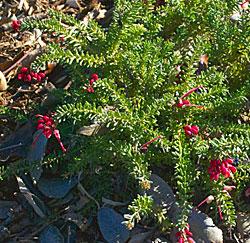
|
Grevillea lanigera 'Coastal Gem' Blooming as early as December and through winter into spring this low growing (1 foot tall by 4 feet wide), evergreen spreading shrub from Australia is extremely drought tolerant. It is also deer resistant. Sometimes known as “woolly” grevillea due to its soft, gray green leaves, it makes a good border, rock garden or ground cover plant. We have it planted on a slope (to improve drainage) at the entrance of our perennial path. Preferring full sun and neutral to slightly acidic fertile well drained soil, it can also handle some light shade in our climate. |
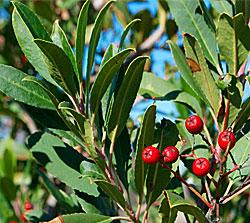
|
Heteromeles arbutifolia Found at the entrance of the Native garden, this evergreen native rose family large shrub (or small multi-trunked tree) carrying the name given by the Ohlone, toyon, bears gorgeous clusters of red berries on stems of glossy, leathery leaves just in time for the holiday season. Unpalatable until the berries have ripened and fermented many birds will have their own tipsy holiday feast on these brilliant berries. Abundantly found in chaparral and woodlands from Humboldt County to Baja California and in the Sierras below 4000 feet it is also known as or Christmas berry or California holly. It is the namesake of the city of Hollywood. Toyon is usually grown as a large accent shrub or small multi-trunked tree. Mature plants can be 8 to15 feet tall and wide. Adaptable to a wide range of soils, moisture conditions and exposure, it does best with good drainage and only light shade. Hedging and hard pruning is not recommended and young specimens up to 2 years may be more vulnerable to pathogens but once established, toyons are long lived and low-maintenance. Plants can harbor low levels of many pests, including aphids, scale, mealy bugs but usually they do not cause significant damage to established specimens. Clusters of small white blossoms mature to berries in winter. While we have planted our toyon as an accent plant with Spreading California aster, California fuchsia and Cleveland sages, it also can be combined in a shrub grouping with other California natives such as manzanitas and ceanothus. A UC Davis Arboretum All-Star selection. |
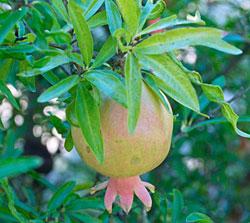
|
Punica granatum ‘Nana’ Pomegranates, which are natives of Northern Africa, Iran, Afghanistan, and the Himalayas, have been in California since the 1770s. Featured at the entrance to our "Commonly Available" garden area, this dwarf variety bears fall ripening fruit that is primarily decorative. It is generally evergreen in Sacramento. Tolerant of many soil types, including alkaline soils, heat and cold, and drought tolerant, it makes a good foundation shrub, hedge, accent or small tree. ‘Nana’ grows to 3 feet high by 6 feet wide. |
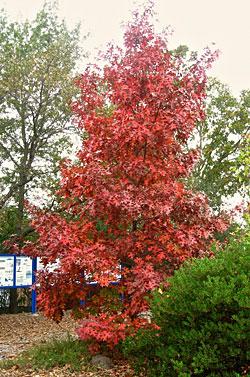
|
Quercus coccinea |




